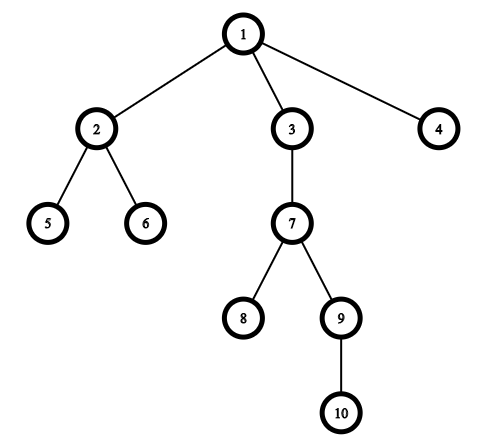Preparando MOJI
You are given a rooted tree consisting of $$$n$$$ vertices numbered from $$$1$$$ to $$$n$$$. The root of the tree is a vertex number $$$1$$$.
A tree is a connected undirected graph with $$$n-1$$$ edges.
You are given $$$m$$$ queries. The $$$i$$$-th query consists of the set of $$$k_i$$$ distinct vertices $$$v_i[1], v_i[2], \dots, v_i[k_i]$$$. Your task is to say if there is a path from the root to some vertex $$$u$$$ such that each of the given $$$k$$$ vertices is either belongs to this path or has the distance $$$1$$$ to some vertex of this path.
The first line of the input contains two integers $$$n$$$ and $$$m$$$ ($$$2 \le n \le 2 \cdot 10^5$$$, $$$1 \le m \le 2 \cdot 10^5$$$) — the number of vertices in the tree and the number of queries.
Each of the next $$$n-1$$$ lines describes an edge of the tree. Edge $$$i$$$ is denoted by two integers $$$u_i$$$ and $$$v_i$$$, the labels of vertices it connects $$$(1 \le u_i, v_i \le n, u_i \ne v_i$$$).
It is guaranteed that the given edges form a tree.
The next $$$m$$$ lines describe queries. The $$$i$$$-th line describes the $$$i$$$-th query and starts with the integer $$$k_i$$$ ($$$1 \le k_i \le n$$$) — the number of vertices in the current query. Then $$$k_i$$$ integers follow: $$$v_i[1], v_i[2], \dots, v_i[k_i]$$$ ($$$1 \le v_i[j] \le n$$$), where $$$v_i[j]$$$ is the $$$j$$$-th vertex of the $$$i$$$-th query.
It is guaranteed that all vertices in a single query are distinct.
It is guaranteed that the sum of $$$k_i$$$ does not exceed $$$2 \cdot 10^5$$$ ($$$\sum\limits_{i=1}^{m} k_i \le 2 \cdot 10^5$$$).
For each query, print the answer — "YES", if there is a path from the root to some vertex $$$u$$$ such that each of the given $$$k$$$ vertices is either belongs to this path or has the distance $$$1$$$ to some vertex of this path and "NO" otherwise.
10 6 1 2 1 3 1 4 2 5 2 6 3 7 7 8 7 9 9 10 4 3 8 9 10 3 2 4 6 3 2 1 5 3 4 8 2 2 6 10 3 5 4 7
YES YES YES YES NO NO
The picture corresponding to the example:

Consider the queries.
The first query is $$$[3, 8, 9, 10]$$$. The answer is "YES" as you can choose the path from the root $$$1$$$ to the vertex $$$u=10$$$. Then vertices $$$[3, 9, 10]$$$ belong to the path from $$$1$$$ to $$$10$$$ and the vertex $$$8$$$ has distance $$$1$$$ to the vertex $$$7$$$ which also belongs to this path.
The second query is $$$[2, 4, 6]$$$. The answer is "YES" as you can choose the path to the vertex $$$u=2$$$. Then the vertex $$$4$$$ has distance $$$1$$$ to the vertex $$$1$$$ which belongs to this path and the vertex $$$6$$$ has distance $$$1$$$ to the vertex $$$2$$$ which belongs to this path.
The third query is $$$[2, 1, 5]$$$. The answer is "YES" as you can choose the path to the vertex $$$u=5$$$ and all vertices of the query belong to this path.
The fourth query is $$$[4, 8, 2]$$$. The answer is "YES" as you can choose the path to the vertex $$$u=9$$$ so vertices $$$2$$$ and $$$4$$$ both have distance $$$1$$$ to the vertex $$$1$$$ which belongs to this path and the vertex $$$8$$$ has distance $$$1$$$ to the vertex $$$7$$$ which belongs to this path.
The fifth and the sixth queries both have answer "NO" because you cannot choose suitable vertex $$$u$$$.